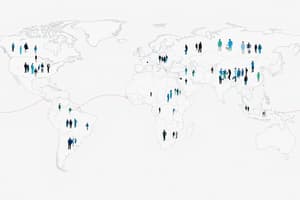Podcast
Questions and Answers
How is global stratification different from social stratification?
How is global stratification different from social stratification?
Global stratification examines a myriad of different types of prejudice and inequality, while social stratification covers the social class and standing of individuals.
An example of slavery, according to Anti-Slavery International, is what?
An example of slavery, according to Anti-Slavery International, is what?
Factories using child labor
Maria is a part of the ________.
Maria is a part of the ________.
Underground economy
How do companies manage to outsource work despite negative perceptions in the United States?
How do companies manage to outsource work despite negative perceptions in the United States?
Signup and view all the answers
88 million people live on less than $1.00 a day. These people are said to be living in ________.
88 million people live on less than $1.00 a day. These people are said to be living in ________.
Signup and view all the answers
Immanuel Wallerstein's classification of nations uses which set of terms?
Immanuel Wallerstein's classification of nations uses which set of terms?
Signup and view all the answers
The two regions with the highest risk of social unrest are?
The two regions with the highest risk of social unrest are?
Signup and view all the answers
Which continent has the greatest number of impoverished nations in the world?
Which continent has the greatest number of impoverished nations in the world?
Signup and view all the answers
Areas that once had vast economic growth and large amounts of industry, but are now suffering from the effects of outsourcing are going through a period of?
Areas that once had vast economic growth and large amounts of industry, but are now suffering from the effects of outsourcing are going through a period of?
Signup and view all the answers
Which number does the World Bank use to determine the status and classification of each nation?
Which number does the World Bank use to determine the status and classification of each nation?
Signup and view all the answers
They will have a(n) _______ marriage.
They will have a(n) _______ marriage.
Signup and view all the answers
This kind of purchasing, driven by desire to display wealth, is called?
This kind of purchasing, driven by desire to display wealth, is called?
Signup and view all the answers
What seems to be the key to upward social mobility?
What seems to be the key to upward social mobility?
Signup and view all the answers
How much of the US wealth is held by the wealthiest top 1% of people?
How much of the US wealth is held by the wealthiest top 1% of people?
Signup and view all the answers
Which factor is considered when evaluating someone's standard of living?
Which factor is considered when evaluating someone's standard of living?
Signup and view all the answers
What does the Davis-Moore Thesis state?
What does the Davis-Moore Thesis state?
Signup and view all the answers
Which historical event was greatly responsible for global stratification as we see it today?
Which historical event was greatly responsible for global stratification as we see it today?
Signup and view all the answers
What is the most significant threat to the relatively high standard of living people are accustomed to in the United States?
What is the most significant threat to the relatively high standard of living people are accustomed to in the United States?
Signup and view all the answers
One main issue in studying global social inequality is?
One main issue in studying global social inequality is?
Signup and view all the answers
Elisa's hard work was rewarded with a rise and a bonus. This form of promotion is based on the principles of?
Elisa's hard work was rewarded with a rise and a bonus. This form of promotion is based on the principles of?
Signup and view all the answers
Study Notes
Global Stratification vs. Social Stratification
- Global stratification assesses widespread forms of prejudice and inequality globally.
- Social stratification focuses on individual social class and status within a society.
Modern Examples of Slavery
- Child labor in factories is recognized as a modern form of slavery by Anti-Slavery International.
Economic Participation
- Engaging in unreported income, like babysitting while in college, places individuals in the underground economy.
Outsourcing Practices
- Companies outsource to cheaper labor to maintain low consumer prices, despite negative public perception in the U.S.
Absolute Poverty Statistics
- A staggering 88 million individuals live on less than $1.00 per day, classified as experiencing absolute poverty.
Wallerstein's Nation Classification
- Nations are categorized into three groups: core, peripheral, and semi-peripheral nations.
Regions of Social Unrest
- Sub-Saharan Africa and the Middle East-North Africa are identified as regions with the highest risk of social unrest.
Poverty Concentration
- Africa hosts the greatest number of impoverished nations globally.
Economic Transition
- Regions facing deindustrialization have shifted from robust economic growth and industrial activity to decline due to outsourcing effects.
World Bank Classification Metric
- The World Bank classifies nations based on Gross National Income per Capita.
Marriage Types
- A wedding between individuals from differing social backgrounds, like a Senator's daughter and a farmer, represents an exogamous marriage.
Consumer Behavior
- Purchases made to display wealth, like a $5,000 designer bag, are referred to as conspicuous consumption.
Social Mobility Factors
- Education level is key to achieving upward social mobility.
Wealth Distribution in the U.S.
- The top 1% of wealth holders in the U.S. control approximately one-third of the total national wealth.
Standard of Living Evaluation
- Standard of living considers multiple factors, including income, employment, and social class.
Davis-Moore Thesis
- This sociological theory posits that professions valued by society tend to offer higher rewards and salaries.
Historical Influence on Global Stratification
- The Industrial Revolution significantly shaped current global stratification patterns.
Threats to Standard of Living
- The decline of the middle class is cited as the most significant threat to the high standard of living in the U.S.
Challenges in Social Inequality Studies
- Social inequality varies greatly across cultures, making it challenging to compare effectively.
Meritocracy in Advancement
- Promotion based on individual performance, such as Elisa’s rise in her career, illustrates the concept of meritocracy.
Studying That Suits You
Use AI to generate personalized quizzes and flashcards to suit your learning preferences.
Description
This quiz explores the differences between global and social stratification, examining modern forms of slavery, economic participation, and outsourcing practices. It also covers current statistics on absolute poverty and Wallerstein's classification of nations. Test your understanding of these critical social issues.




